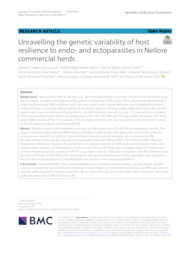Unravelling the genetic variability of host resilience to endo and ectoparasites in Nellore commercial herds.
Unravelling the genetic variability of host resilience to endo and ectoparasites in Nellore commercial herds.
Author(s): GOUVEIA, G. C.; RIBEIRO, V. M. P.; FORTES, M. R. S.; RAIDAN, F. S. S.; REVERTER, A.; PORTO-NETO, L. R.; MORAES, M. M. de; GONÇALVES, D. R.; SILVA, M. V. G. B.; TORAL, F. L. B.
Summary: BACKGROUND- Host resilience (HR) to parasites can afect the performance of animals. Therefore, the aim of this study was to present a detailed investigation of the genetic mechanisms of HR to ticks (TICK), gastrointestinal nematodes (GIN), and Eimeria spp. (EIM) in Nellore cattle that were raised under natural infestation and a prophylactic parasite control strategy. In our study, HR was defned as the slope coefcient of body weight (BW) when TICK, GIN, and EIM burdens were used as environmental gradients in random regression models. In total, 1712 animals were evaluated at fve measurement events (ME) at an average age of 331, 385, 443, 498, and 555 days, which generated 7307 body weight (BW) records. Of the 1712 animals, 1075 genotyped animals were used in genome-wide association studies to identify genomic regions associated with HR. RESULTS- Posterior means of the heritability estimates for BW ranged from 0.09 to 0.54 across parasites and ME. The single nucleotide polymorphism (SNP)-derived heritability for BW at each ME ranged from a low (0.09 at ME.331) to a moderate value (0.23 at ME.555). Those estimates show that genetic progress can be achieved for BW through selection. Both genetic and genomic associations between BW and HR to TICK, GIN, and EIM confrmed that parasite infestation impacted the performance of animals. Selection for BW under an environment with a controlled parasite burden is an alternative to improve both, BW and HR. There was no impact of age of measurement on the estimates of genetic variance for HR. Five quantitative trait loci (QTL) were associated with HR to EIM but none with HR to TICK and to GIN. These QTL contain genes that were previously shown to be associated with the production of antibody modulators and chemokines that are released in the intestinal epithelium. CONCLUSIONS- Selection for BW under natural infestation and controlled parasite burden, via prophylactic parasite control, contributes to the identifcation of animals that are resilient to nematodes and Eimeria ssp. Although we verifIed that sufcient genetic variation existed for HR, we did not fnd any genes associated with mechanisms that could justify the expression of HR to TICK and GIN.
Publication year: 2023
Types of publication: Journal article
Unit: Embrapa Dairy Cattle
Observation
Some of Embrapa's publications are published as ePub files. To read them, use or download one of the following free software options to your computer or mobile device. Android: Google Play Books; IOS: iBooks; Windows and Linux: Calibre.
Access other publications
Access the Agricultural Research Database (BDPA) to consult Embrapa's full library collection and records.
Visit Embrapa Bookstore to purchase books and other publications sold by Embrapa.

